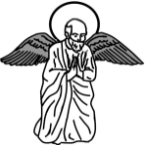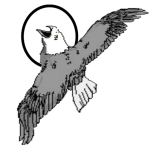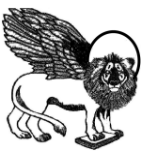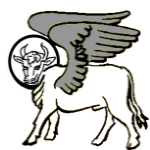Evangelists' Cross

The four Evangelists (Matthew, Mark, Luke and John) are depicted here as a winged man, an eagle, a winged lion and a winged ox (or calf).
Yes, those creatures do appear as mythological Chimæras who, along with dragons and other beasties, are generally considered Bad News. Their appearance in the Bible is not evidence that the Bible is just trumped-up mythology; rather they are a rhetorical device to symbolise certain concepts. The creatures are derived from the priest Ezekiel's prophecy after seeing a vision.
Putting aside the claims by UFOlogists that Ezekiel witnessed flying saucers, we can imagine the prophet believed he was seeing a vision of God being served by Cherubim angels – winged creatures ready to fly out swiftly at God's command to do His work. In particular, this involved spreading the news of salvation, also known as 'Gospel'. This cross can therefore also be called the Gospel Cross. (See also Mission Cross.)
 |  | |||||
Matthew is represented (top left) as a Winged Man because he began his Gospel with the human Jesus, tracing a lineage to David. (In some drawings the Winged Man holds a sword and scales, representing the Archangel Michael.) | ||||||
John is represented (top right) as an Eagle because of his "soaring" witness to Jesus' divine nature. Even soaring at high altitudes, the eagle is quick and sharp-sighted. An early legend held that the eagle would periodically renew its youth by flying near the sun and then plunging into a lake or fountain; hence it became a symbol for the Resurrection.
Mark (bottom left) represented as a Lion, strong and bold. The wings emphasize his proclamation of Jesus' resurrection. Since lion cubs are born small and immobile with their eyes shut for the first few days, there's a myth they're born dead but come to life after three days; reminding us of the Resurrection. Another idea is that lions sleep with eyes open, making them symbols of watchfulness. In fact lions close their eyes when asleep. Like other felidae, their sleep lasts on average 14 hours a day, so their eyes do open and close as they drift through various levels of sleep, as you might notice with your cat. | ||||||
Finally, we introduce Luke (bottom right) as an Ox or calf because their strength, diligence and patience for the work to be done. As a sacrificial animal, the calf reminds us of Jesus' sacrifice. | ||||||
 |  | |||||
...or at least, that's the interpretation suggested by St. Jerome. Other great theologians and developers of Western Christianity had different views, as shown by one of our contributors:
In its early days, the Church began to associate the four evangelists with the four living creatures of Ezechiel 10:14 and Rev. 4:6-8. For instance, the writings of St. Irenæus, who first makes the association, date to the mid-100s. Other Christian theologians from the first four centuries of the Christian era had differing opinions, as seen in the table following:
| According to... | Man/ Angel | Lion | Ox | Eagle |
| St. Irenæus of Lyons | Matt. | John | Luke | Mark |
| St. Augustine of Hippo | Mark | Matt. | Luke | John |
| Pseudo-Athanasius | Matt. | Luke | Mark | John |
| St. Jerome | Matt. | Mark | Luke | John |
In time iconographers and theologians adopted St. Jerome's reasoning as follows:
- Matthew is represented by the man since his Gospel starts with the human ancestry of Jesus;
- Mark begins his Gospel with John the Baptist, "the voice of one crying in the wilderness," as would a roaring lion;
- Luke, opening with the vision of the priest, Zachary, is assigned the ox, the beast of sacrifice;
- John is associated with the eagle due to the sublimity of his soaring theological insights regarding the union of God and man in Jesus, the Word made flesh (John 1:14).
In addition, since the eagle soars upwards, it became a symbol for Christ's Ascension. Eagles also represent Christians who have died and risen again. "Those who hope in the LORD will renew their strength. They will soar on wings like eagles." Isa. 40:31
The Evangelist winged lion should not be confused with Daniel's winged lion (the First Beast) Dan. 7:4, rather the symbolism is in the boldness of a lion: Prov. 28:1, 30:30.
The lion has been adopted in various ecclesiastical emblems, such as the logo of the Greek Orthodox Patriarchate of Alexandria & all Africa (GOPA) patriarchateofalexandria.com
That's right; lions and oxen don't have wings. But hey! this is about symbology; not zoology. And for something completely different: Albert and the Lion
The watchfulness of a lion: Rev. 5:5
Thanks to Walt Disney, we know from "Lion King" that lions are not born dead. But the movie does teach us a thing or two about resurrection.
